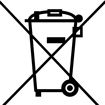RoHS & WEEE
Restriction of the use of certain Hazardous Substances in electrical and electronic equipment
The restriction of dangerous materials in products is a world-wide trend. For this purpose the RoHS directive was implemented in Europe. From 1st July 2006 this directive restricts the use of six materials in the manufacture of various types of electronic and electrical equipment: Lead, mercury, cadmium, hexavalent chromium, polybrominated biphenyls (PBB) and polybrominated diphenyl ether (PBDE).
RoHS applies to categories that are referring primarily to consumer goods:
- Large household devices
- Small household devices
- IT and telecommunications equipment
- Consumer equipment
- Lighting equipment
- Electrical and electronic tools with exception of fixed industrial tools
- Toys, sports and leisure equipment
- Automatic dispensers
The majority of products and equipment sold by Hager are not affected by the categories mentioned above and therefore do not have to be compliant with the RoHS directive which took effect on the 1st July 2006.
As a certified company and according to our environmental protection philosophy, it is a matter of course that we voluntary adapt all products to the RoHS standard within a worldwide programme, so exceeding the legal requirements. By using the contact form of your national Hager website you will get to know when the respective products will be available conforming to RoHS.
To answer your questions in case of doubt, please contact your partners from sales and service or send an email to rohs@hager.com
Waste Electrical and Electronic Equipment
Human activity generates more and more waste. To protect natural resources and our environment, the prevention and the recycling of waste has become a major issue.
To protect human lives and the environment, the European Commission published the WEEE directive 2002 / 96 / CE, it's objective is to define the conditions of collection, storage, treatment and recycling of the electric and electronic products.
The products concerned by the directive are identified with the symbol of the crossed-out wheeled bin.
This marking shown on the product or its documentation indicates that it should not be disposed with other household waste at the end of its working life.
To prevent possible harm to the environment or human health from uncontrolled waste disposal, it has to be separated from other types of waste and recycled in a responsible way to promote the sustainable reuse of material resources.
Household users should contact either the retailer where they purchased this product, or their local government office, for details of where and how they can get rid of this item for environmentally safe recycling.
Business users should contact their supplier and check the terms and conditions of the purchase contract. This product should not be mixed with other commercial waste.
End of life treatment of electrical/electronic equipment and batteries in the European Union Countries.
 The crossed-out ‘wheeled bin symbol’ marked on the equipment or its packaging, indicates that the product is not to be disposed of with unsorted municipal / household waste. Please check with your local authority or retailer for recycling and collection advice. This will enable you to contribute to the disposal, treatment and recycling in an environmentally sound way and help prevent potential negative effects on the environment and human health.
The crossed-out ‘wheeled bin symbol’ marked on the equipment or its packaging, indicates that the product is not to be disposed of with unsorted municipal / household waste. Please check with your local authority or retailer for recycling and collection advice. This will enable you to contribute to the disposal, treatment and recycling in an environmentally sound way and help prevent potential negative effects on the environment and human health.
Policies and certificates
- Terms and conditions
- Product warranties
- UK tax policy
- Returns & stock cleanse Policy
- Customer care policy
- Integrated Business Management Systems Policy (QHSE)
- REACH Declaration
- Sustainable Growth & Ethics
- RoHS & WEEE
- Carriage & Minimum Order Charges
- Counterfeiting
- Global cookie notice
- Anti-Slavery and Human Trafficking Statement
- Training: Changes, Cancellation and Refund Policy
- Privacy
